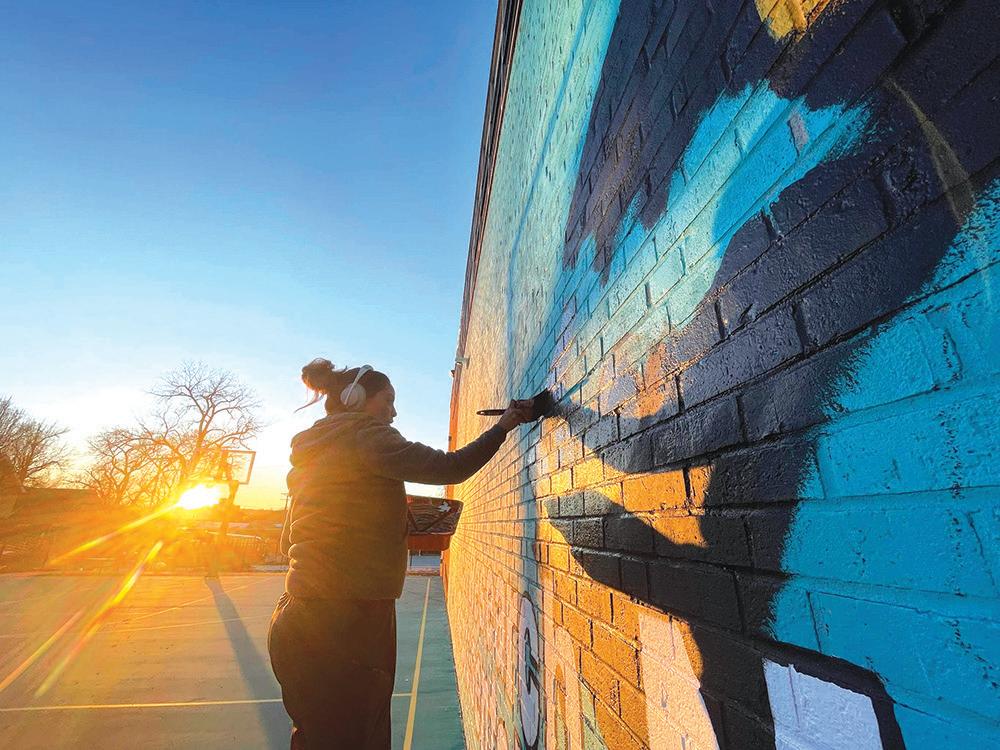
9 minute read
4Allthecommunity
from 2masa2KC-v09e10
by 2más2KC
Westside’s new mural with a special purpose
Nuevo mural del Westside con un propósito especial
Advertisement
New mural calls for new faces in
Cancer Research
Four larger portraits now adorn one side of Guadalupe Centers Middle School in a work done by muralist Vania Soto. At the bottom reads a call to action for the local community: “Clinical Research Needs Representation.”
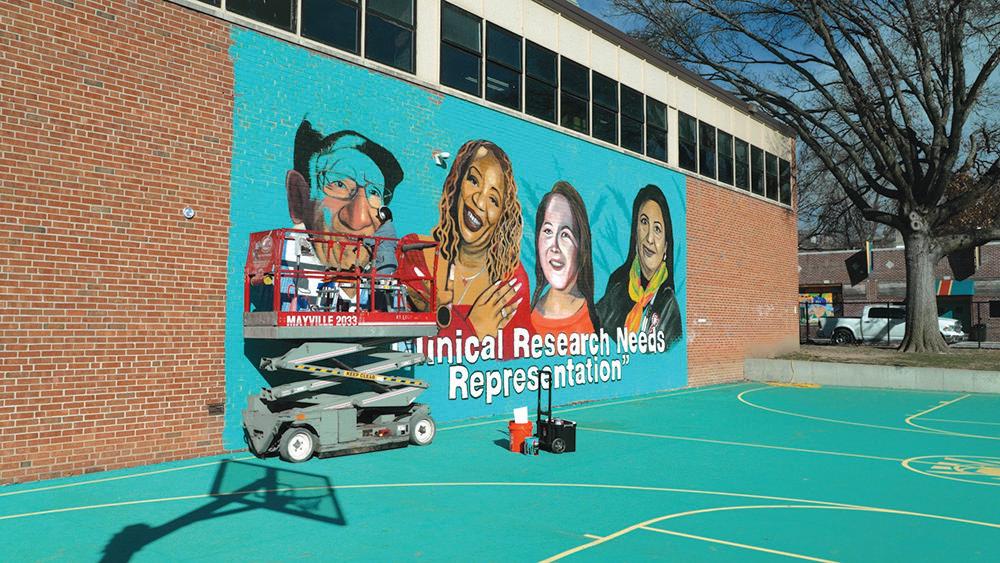
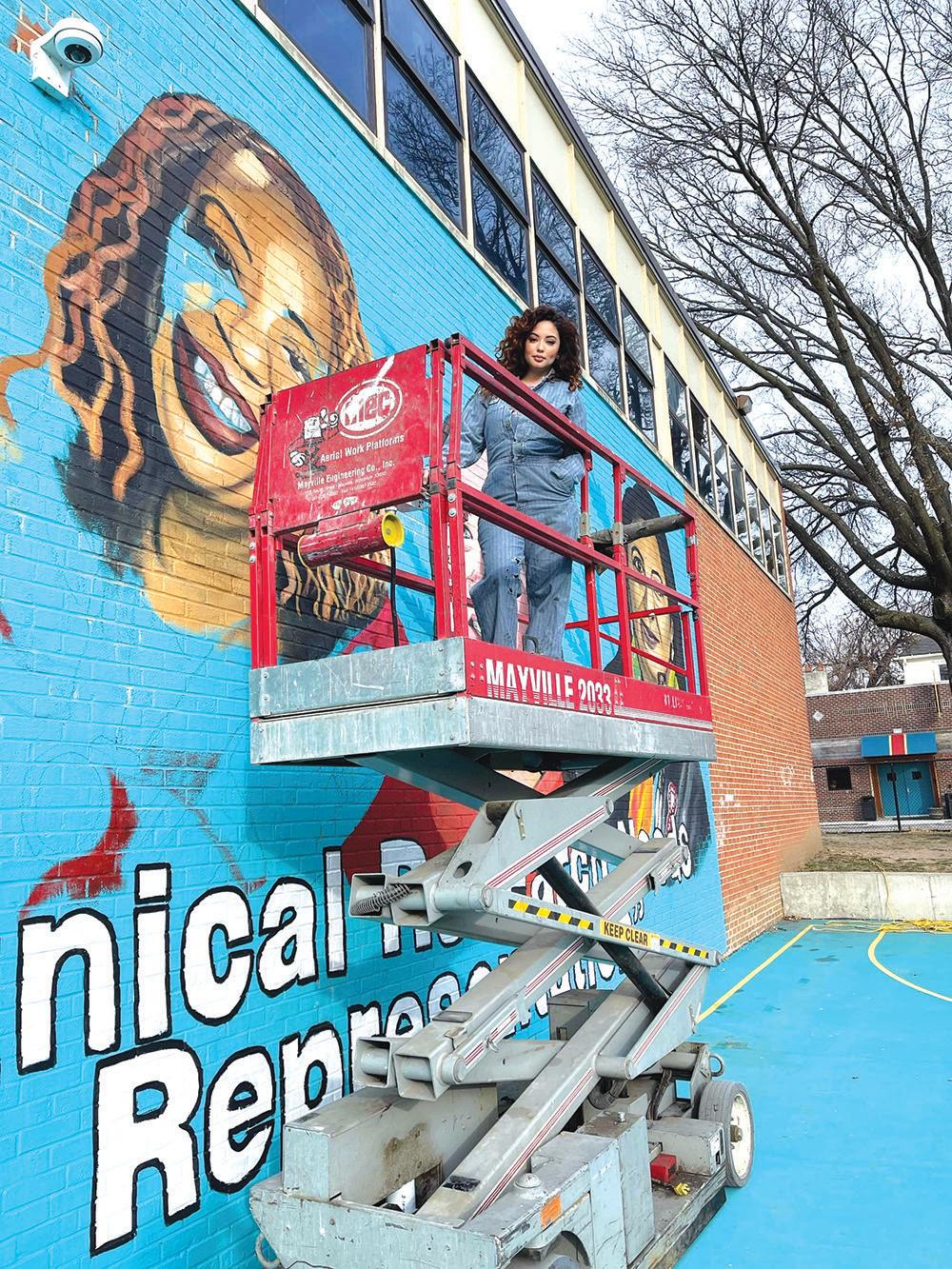
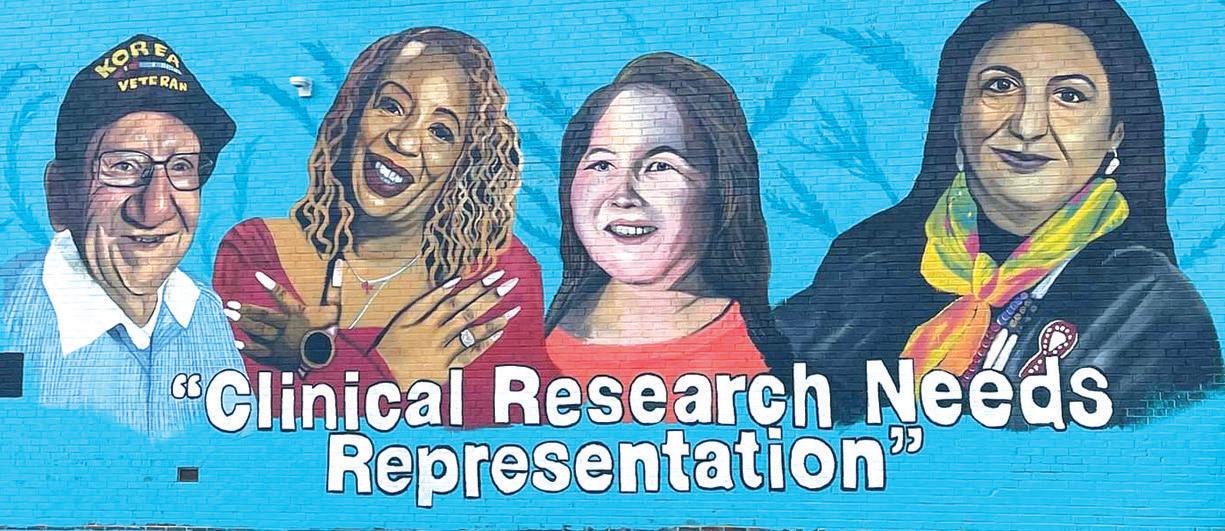
“I’ve learned that not a lot of people of color really sign up for these trials, so it’s really hard to pass trials when there isn’t a lot of diversity,” Soto said.
“The underrepresentation of certain patient populations in clinical trials is a national problem, and it’s a problem that we have locally as well,” said Ronald Chen, M.D., MPH, associate director of health equity at the KU Cancer Center in a statement KU Medical Center released announcing the mural.
Underrepresentation of minorities in clinical trials —a factor which can affect both individuals who can miss out on powerful, experimental drugs and populations because drugs have not been tested on diverse patients— is an important issue that deserves to be told in a meaningful, clear and bold way, Soto said. Murals do that in a way that other art can’t.
“Public art is powerful, knowing
By Jesús López-Gómez
Nuevo mural hace un llamado a nuevas caras en la investigación del cáncer facebook.com/2mas2KC Twitter, Tumblr, Linkedin, issuu, Pinterest, Instagram
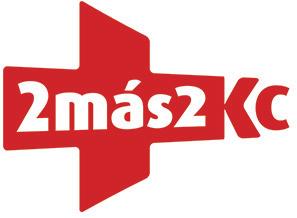
CÉSAR LOZANO: Con el rencor a cuestas pág.7
COMMUNITY: The practice of death penalty pág.3 that someone painted a mural by hand, has a deeper connection to the viewer,” Soto said. “Cancer is something very personal, just like art, I believe community murals are the best way to make that connection. In this case, even save lives!”
Cuatro retratos más grandes ahora adornan un lado de la escuela secundaria Guadalupe Centers en un trabajo realizado por la muralista Vania Soto. En la parte inferior se lee un llamado a la acción para la comunidad local: “La investigación clínica necesita representación”.
“He descubierto que no muchas personas de color realmente se inscriben en estas pruebas, por lo que es muy difícil aprobar ensayos clínicos cuando no hay mucha diversidad”, dijo Vania.
“La subrepresentación de ciertas poblaciones de pacientes en los ensayos clínicos es un problema nacional, y también es un problema que tenemos a nivel local”, indicó Ronald Chen, M.D., MPH, Director Adjunto de Equidad en Salud en el Centro de Cáncer de KU en un comunicado del Centro Médico de KU anunciando el mural.
La subrepresentación de las minorías en los ensayos clínicos —un factor que puede afectar tanto a las personas que pueden perderse fármacos experimentales potentes como a las poblaciones porque los fármacos no han sido probados en diversos pacientes— es un tema importante que merece ser abordado de forma significativa, clara y de manera audaz, informó Vania. Los murales hacen eso de una manera que otro arte no puede.
“El arte público es poderoso, y saber que alguien pintó un mural a mano, tiene una conexión más profunda con el espectador”, comentó Vania. “El cáncer es algo muy personal, al igual que el arte, creo que los murales comunitarios son la mejor manera de hacer esa conexión. En este caso, ¡incluso
Inicia Horario De Verano Inicia Horario De Verano
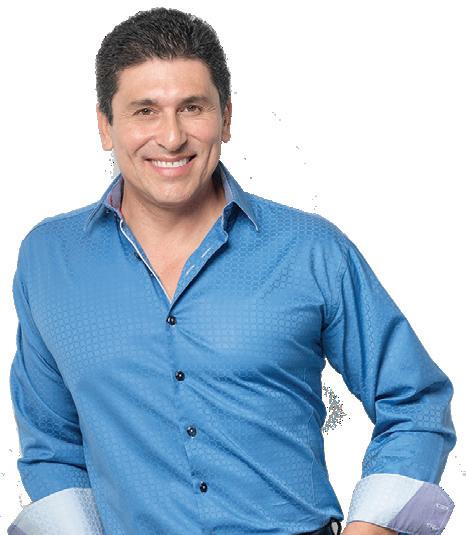

Adelanta tu reloj 1 hora este domingo en la madrugada
ENTERTAINMENT: Forbidden Broadway pág.7
COMMUNITY: Benefits of breastfeeding pág.6
Soto said painting the mural “took about a month, would have been a shorter amount of time if it wasn’t for the crazy-Midwest-weather.” salvar vidas!”
The four people featured in the mural have participated in the KU Cancer Center’s campaign to encourage minority participation in cancer trials. Among them is breast cancer survivor Kim Jones and Paul Rojas, a fellow survivor. Isabella Rider (Minor) and Tonya Negonsott-Rodvett also share the mural, too. A QR code will later be installed at the mural educating the public on different types of cancer.
“I think once the QR codes go up there will be more engagement. So far there is a lot of people stopping by and taking pictures wanting to know more about the mural!” Soto said.
Soto’s mural and Guadalupe Centers Middle School is located at 2640 Belleview Ave, Kansas City, Mo.
Vania dijo que pintar el mural “tomó alrededor de un mes, hubiera sido menos tiempo si no fuera por el clima loco del Medio Oeste”.
Las cuatro personas que aparecen en el mural han participado en la campaña del Centro de Cáncer de KU para fomentar la participación de las minorías en los ensayos de cáncer. Entre ellos se encuentra la sobreviviente de cáncer de mama Kim Jones y Paul Rojas, otro sobreviviente.
Isabella Rider (Menor) y Tonya Negonsott-Rodvett también comparten el mural.
Posteriormente se instalará un código QR en el mural para educar al público sobre los diferentes tipos de cáncer.
“Creo que una vez que se publiquen los códigos QR, habrá más participación”.
“¡Hasta ahora hay mucha gente pasando y tomando fotos queriendo saber más sobre el mural!” concluyó Vania.
El mural de Vania y la escuela secundaria Guadalupe Centers están ubicados en 2640 Belleview Ave, Kansas City, Mo.
EDITOR
Elizabeth López
ADVERTISING MANAGER
Gerente de Ventas
Eduardo Alvarado R.
REPORTERS / WRITERS
Reporteros / Escritores
Eduardo Alvarado L.
Lalo Alvarado R.
La Poblanita
Jesús López-Gómez
Enrique ‘Kike’ Morales
Rita Sherrie
PHOTOGRAPHERS
Fotógrafos
Lalo Alvarado R.
Sergio Nolasco
TRANSLATORS
Traductores
Elizabeth López
Eduardo Alvarado L.
CORRECTORA DE ESTILO
Lucía Rodríguez
SALES
Ventas
Rebecca Bourgeois
Angélica Ríos sales@2mas2kc.com
DISTRIBUTION
Distribución
Eduardo Alvarado Rodríguez
Juan Carlos Alvarado López
DESIGN CONSULTANT
Asesora de Diseño
Martha Lauría Grundke
Lauria Communication + Design DESIGN
Diseño
Gabriela M. López A.
2mas2KC is a weekly publication of 2mas2KC, LLC. The articles published do not necessarily reflect the opinions of this publication and each article is the sole responsibility of its author.
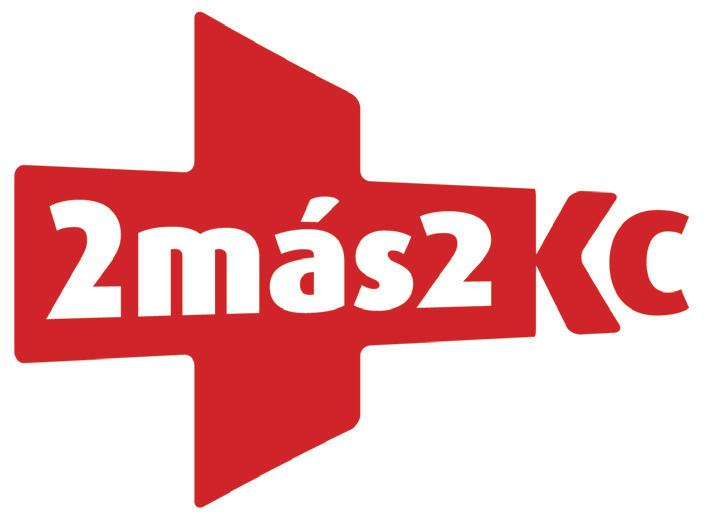
2mas2KC cannot endorse or guarantee the products or services offered by advertisers in this publication. Each advertiser is responsible for the veracity of their advertisement.
2mas2KC es una publicación semanal de
2mas2KC, LLC. Los artículos publicados no reflejan necesariamente la opinión de este medio y cada artículo es responsabilidad exclusiva de su autor.
2mas2KC no puede garantizar ni respaldar los productos o servicios ofrecidos por los anun_ ciantes en esta publicación. Cada uno de ellos es responsable de la veracidad de su anuncio.
We value your opinions and contributions!
¡Valoramos tus opiniones y contribuciones!
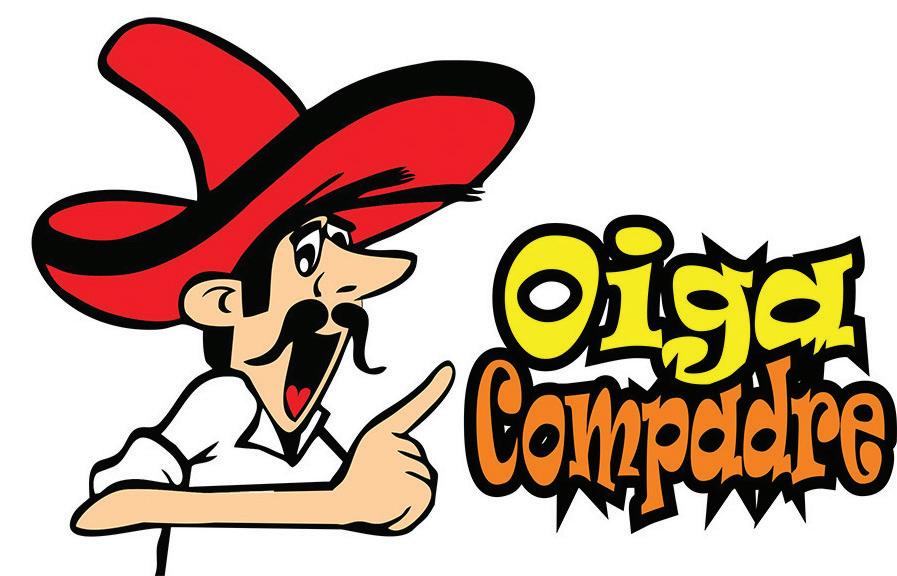
Send them to: Envíalas a: liza.lopez@2mas2KC.com
8500 W. 71st. Street
Overland Park, KS. 66204 facebook.com/2mas2kc www.2mas2kc.com
(913) 432 -3486
Proud member of:
Simple vs Easy: Understanding the crucial difference
When faced with a task or a problem, many people use the words “simple” and “easy” interchangeably. After all, the two words sound similar and are often used in similar contexts. However, understanding the crucial difference between the two can help individuals make better decisions, solve problems more effectively, and achieve their goals more efficiently.
At its core, the difference between simple and easy lies in their definitions. Simple refers to something that is not complex or difficult to understand, while easy refers to something that can be done with little effort or difficulty. While these definitions may seem similar, the implications of their meanings are quite different.
Something can be simple but not easy. For example, solving a mathematical equation may be simple in the sense that it is not complex, but it may not be easy because it requires a significant amount of mental effort and concentra tion. Similarly, learning a new language may be simple in the sense that it involves learning a set of rules, but it may not be easy because it requires consistent practice and dedication.
On the other hand, something can be easy but not simple. For example, driving a car may be easy for someone who has been doing it for years, but it is not necessarily simple because it involves multiple steps and requires a certain level of skill. Similarly, creating a successful business may be easy for someone with a lot of experience and resources, but it is not necessarily simple because it involves multiple complex factors such as market research, financial planning, and customer outreach.
Understanding the difference between simple and easy is crucial because it can help individuals set realistic goals and expectations for themselves. When faced with a task or a problem, individuals should take the time to assess whether it is simple or easy, and then adjust their approach accordingly.
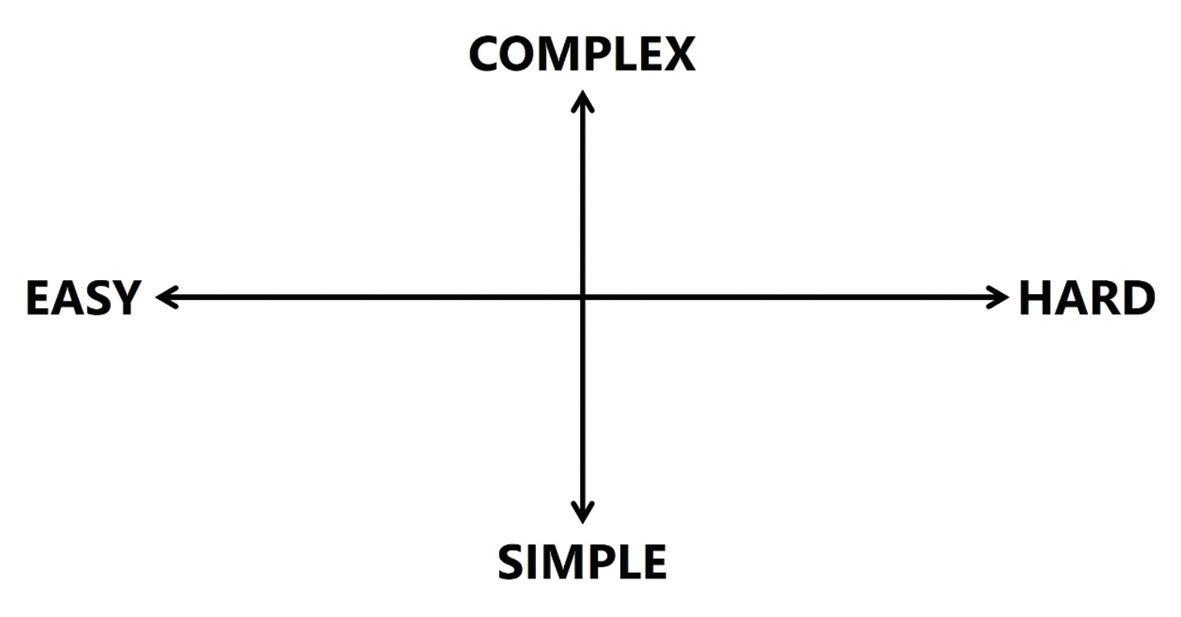
If something is simple but not easy, individuals should focus on breaking it down into smaller, more manageable steps and allocating the necessary time and resources to complete each step. This may involve seeking help or guidance from others, developing a consistent practice routine, or taking breaks when needed to avoid burnout.
If something is easy but not simple, individuals should focus on developing the necessary skills and knowledge to make it simple. This may involve investing in education or training, seeking mentorship or coaching from experienced professionals, or conducting research and analysis to better understand the underlying factors that contribute to success.
In conclusion, the difference between simple and easy may seem small, but it has a significant impact on how individuals approach and solve problems. By understanding the crucial difference between the two, individuals can set realistic goals, develop effective strategies, and achieve success in all areas of their lives.
Simple vs. fácil: Entendiendo la crucial diferencia
Cuando se enfrentan a una tarea o un problema, muchas personas usan las palabras “simple” y “fácil” indistintamente. Después de todo, las dos palabras suenan similares y se usan a menudo en contextos similares. Sin embargo, entender la diferencia crucial entre las dos puede ayudar a las personas a tomar mejores decisiones, resolver problemas de manera más efectiva y alcanzar sus objetivos de manera más eficiente. En su esencia, la diferencia entre simple y fácil radica en sus definiciones. Simple se refiere a algo que no es complejo o difícil de entender; mientras que fácil se refiere a algo que se puede hacer con poco esfuerzo o dificultad. Aunque estas definiciones pueden parecer similares, las implicaciones de sus significados son bastante diferentes. Algo puede ser simple pero no fácil. Por ejemplo, resolver una ecuación matemática puede ser simple en el sentido de que no es compleja, pero puede no ser fácil porque requiere una cantidad significativa de esfuerzo mental y concentración. De manera similar, aprender un nuevo idioma puede ser simple en el sentido de que implica aprender un conjunto de reglas, pero puede no ser fácil porque requiere práctica y dedicación consistentes.
Por otro lado, algo puede ser fácil pero no simple. Por ejemplo, conducir un automóvil puede ser fácil para alguien que lo ha estado haciendo durante años, pero no es necesariamente simple porque implica múltiples pasos y requiere un cierto nivel de habilidad. De manera similar, crear un negocio exitoso puede ser fácil para alguien con mucha experiencia y recursos, pero no es necesariamente simple porque involucra múltiples factores complejos como investigación de mercado, planeación financiera y acercamiento al cliente.
Comprender la diferencia entre simple y fácil es crucial porque puede ayudar a la gente a establecer objetivos y expectativas realistas para sí misma. Cuando se enfrentan a una tarea o un problema, las personas deben tomarse el tiempo para evaluar si es simple o fácil, y luego ajustar su enfoque en consecuencia. Si algo es simple pero no fácil, deben centrarse en descomponerlo en pasos más pequeños y manejables y asignar el tiempo y los recursos necesarios para completar cada paso. Esto puede implicar buscar ayuda u orientación de otros, desarrollar una rutina de práctica consistente o tomar descansos cuando sea necesario para evitar el agotamiento.
Si algo es fácil pero no simple, deben centrarse en desarrollar las habilidades y el conocimiento necesarios para hacerlo simple. Esto puede implicar invertir en educación o capacitación, buscar tutoría o asesoría de profesionales experimentados o realizar investigaciones y análisis para comprender mejor los factores subyacentes que contribuyen al éxito.
En conclusión, la diferencia entre simple y fácil puede parecer pequeña, pero tiene un impacto significativo en cómo las personas abordan y resuelven problemas. Al entender la diferencia crucial entre las dos, se pueden establecer objetivos realistas, desarrollar estrategias efectivas y lograr el éxito en todas las áreas de la vida.
noche.
_¿Cuántos le gustaría tener? 3, 4, 5.
_¡Cálmese! Ni que fueran conejos.
_ Pues uno nunca sabe.
_ Y qué tal ¿unos gemelos?
_¿Cómo cree? Eso no se puede escoger.
_Ah ¿no?
…¿A usted no le gustaría tener nietos?
_No se compadre... ¡es una decisión muy difícil!
_¿¡Qué!? ¡No sea menso. Eso lo deciden sus hijos!
_Ah, pues sí ¿verdad?
_Me refiero a que si no le gustaría tener ya su descendencia, bebés con su apellido.
_ Pues fíjese que no lo había pensado.
_Imagínese al montón de chamacos alegrando su casa.
_...y llamándome “Tata” o “Abue”.
_Más bien yo creo que sería “Grandpa”.
_Y disfrutarlos sin tanto compromiso.
_Sí y cuidándolos mientras sus papás trabajan.
_¿Y recogiendo su tiradero y cambiando pañales con caca?
_No piense en lo malo. Acuérdese que sus papás los recogerían en la noche.
_Oh, sí y después... a descansar toda la
_No. ¿Sabía usted que de acuerdo a la National Geographic sólo en uno de cada 250 nacen gemelos?
_¿¿¿Uno de cada 250???
_Sip.
_Noooo, ¡yo no aguanto tantos! _¡¡¡Pinche compadre!!!
FRASE DE LA SEMANA:
Open editorial / Editorial abierta







